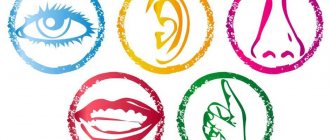The question of how feelings differ from emotions has been addressed in psychology. We all lived through both for the first time in early childhood. However, their depth and versatility are amazing. There is always a little pain in the words “I’m doing great,” sympathy in the phrase “I don’t care,” sarcasm in every “I was joking.” Our heart ensures the movement of blood and dances with joy, bursts with pain, freezes with fear. We hide experiences and display them, we suffer and enjoy, we are captured by them and controlled by them.
Concept and examples of emotions
I'll start with a definition. These are spontaneous states, effects caused by external and internal momentary stimuli. They have important features:
- arise during significant events and situations;
- are a response to a specific phenomenon in a clear time period “here and now”;
- appear unconsciously;
- associated with the release of hormones and neurotransmitter activity;
- are expressed quickly and impulsively, and therefore are more noticeable.
It could be delight, resentment, anger, joy.
They make it possible to adapt to the situation and make an adequate decision. For example, stopping in front of a car rushing at high speed will be helped by fear, and the irritation from the fact that “you are not you when you are hungry” will go away if you eat something tasty. Emotions and feelings are not the same thing, although at the everyday level these concepts are sometimes interchangeable. The external reaction will follow immediately when you are scared by a dog or you get a promotion. It is almost impossible to hide it. It manifests itself:
- at the physiological level, changing hormonal levels;
- in behavior, bitter tears or uncontrollable enthusiastic squealing;
- in cognition, leaving the history of the experience in memory.
Descriptions of external manifestations of emotions
Let us give a description of the external manifestations of some experiences, especially emotions and feelings.
1. Confusion (confusion):
- the head turns away from the observer;
- the gaze is directed downward, while it moves to the side;
- a smile with compressed lips - a “restrained smile”;
- touching your face with your hand.
2. Joy:
- eyebrows and forehead are calm;
- the lower eyelids and cheeks are raised, the eyes are squinted, there are wrinkles under the lower eyelids;
- “crow’s feet” - light wrinkles radiating from the inner corners of the eyes;
- the mouth is closed, the corners of the lips are pulled to the sides and raised.
Expressions of joy are already visible in infants. They react to their mother with a smile, which involves the zygomaticus major muscle and the orbicularis oculi muscle - Dagen's smile. When smiling at a stranger, only the zygomaticus major muscle is activated. Generally speaking, there are quite a lot of different types of smiles. I.E. Repin presented the following types of laughter: subtle smile, vulgar smile, simple-minded laughter, cheerful laughter, mocking laughter, healthy laughter (of a fat man), hefty laughter (ready to result in a hefty brawl), stupid laughter (of a degenerate with a small head and protruding ears), rustic laughter (of a narrow-minded, plump subject), good-natured laughter, sarcastic smile, subtly ironic smile, malicious smile (a person has “on his own mind”), a gaping smile (14 in total).
| | Learn to recognize other people's emotions by their manifestations. Contact a social psychologist. |
L.N. Tolstoy, as you know, described 97 shades of a smile, expressing not only joy, but also other feelings (he also knew about the existence of 85 different eye expressions). At the height of manifestation, joy reaches the level of jubilation, and motor and speech revival occurs, sometimes with verbal iterations of joy. Like, for example, A.S. Pushkin, who, extremely delighted with his creative success, suddenly quickly walked back and forth, every now and then saying: “Oh yes Pushkin, oh yes son of a bitch!”
3. Attention to something sudden, unexpected:
- horizontal folds across the entire width of the forehead;
- raising eyebrows;
- raising the eyelids - “making big eyes.”
4. Mental stress:
- two vertical folds on the nose bridge. Pythagoras, knowing this from his own experience, said: “Do not consult with those who have a smooth forehead - they do not think”;
- eyebrows hang over the eyes;
- eyebrows are made horizontal from arched.
5. Willpower (according to Darwin):
- tightly compressed lips;
- tension in the muscles of the body, hence the vivacity of movements.
6. Sadness:
- the eyebrows are drawn out into a straight line, their inner corners are raised, their outer corners are lowered;
- several transverse wrinkles form on the middle third of the forehead;
- several vertical folds appear on the bridge of the nose (a sign of concentration on problems);
- the eyes are slightly narrowed and become dull (“dull gaze”);
- the corners of the mouth are lowered;
- the pace of movements and speech is slowed (a sign of “weak will”).
7. Anger:
- the eyebrows are elongated in a horizontal line, their inner corners are lowered, the outer corners - in contrast to sadness, are raised - the face of Mephistopheles;
- Transverse folds form on the bridge of the nose.
8. Fear:
- transverse wrinkles on the forehead, in the center of the forehead they are deeper than at the edges;
- wide eyes (“look with all eyes” so as not to miss anything);
- raising the eyelids so that the white of the eyes is exposed between the upper eyelid and the iris;
- the eyebrows rise, become arched and are brought down to the bridge of the nose (an expression of helplessness);
- the mouth is open (“jaw dropped”);
- the corners of the mouth are sharply drawn back (an expression of a delayed cry for help);
- transverse wrinkles in the anterior region of the neck (a rudiment of shrinking - “would curl up into a ball”);
- freezing in place or randomly throwing (paralysis of will or flight movements);
- dry mouth, pale face (the first is a sign that was taken into account by ancient lie detectors; the second has long been known to commanders - A. Macedonian, according to legend, did not take into his army people who turned pale in moments of danger). Bowlby adds to the external signs of fear a wary and tense gaze directed towards the source of the threat, as well as trembling in the legs, arms and body.
External manifestations of fear are close to those of surprise, this confirms the related nature of fear and surprise. The difference between them is believed to be that fear is focused on the consequences of a threatening situation, and surprise is focused on its causes. In manifestations of bewilderment and confusion, such a characteristic gesture as spreading the arms to the sides is often added - a sign of the inability to act or understand something.
9. Anger or “getting into a fight” (Darwin):
- the head is thrown back and half-turned towards the object of anger;
- the palpebral fissures are narrowed, angular, or, on the contrary, exophthalmos appears;
- the eyebrows are lowered, they take a horizontal position and are brought to the bridge of the nose so that vertical folds appear between the eyebrows;
- an unwavering gaze at the object of anger (L.N. Tolstoy);
- noisy breathing;
- clenched fists;
- exposure of fangs;
- scleral hyperemia (“eyes are bloodshot”);
- teeth clenched, teeth grinding, lips tightly compressed.
Anger is one element of the triad of hostility, which also includes disgust and contempt. This affect is much more often than others transformed into pathological.
10. Suspiciousness:
- a fixed gaze fixed on the object of suspicion;
- a sidelong glance (an expression of the desire to distance oneself from the object of the threat);
- weak closure of lips (expression of uncertainty);
- the body is oriented away from the object of threat (an expression of the desire to leave, to move away from danger);
- signs of anger.
I.A. Sikorsky points to a completely realistic artistic depiction of suspicion - a portrait of the Bavarian king Ludwig XI, who suffered from paranoia. The king committed suicide - he drowned himself, drowning at the same time, as happens in cases of extended suicide, and Professor V.A. Gudden (who described the eye syndrome with his name in alcoholic encephalopathy and severe alcoholic delirium: miosis, anisocoria, absence and weakening of photoreaction, convergence disorder). Realist artists generally pay a lot of attention to depicting acts of expression, thereby penetrating into the inner world of prototype characters in paintings, in contrast to artists of the formalist movement in art. In the paintings of the latter, it is not always possible to determine even the gender or age of the character, not to mention his psychology.
11. Envy (from Ovid’s description):
- slow gait;
- pale face;
- a sidelong glance (hidden from the object of envy, which is why M.Yu. Lermontov calls the latter a secret feeling);
- lack of a smile, except in cases where the envious person sees the suffering of other people.
Envy combines elements of hostility and sadness. The Bible already speaks of the bodily disorders that envy causes. W. Shakespeare calls her green-eyed, perhaps because envy can also lead to disorders of pigment metabolism;
12. Doubt (based on the painting by A.A. Ivanov “The Appearance of Christ to the People”, an image of a group of six people who doubt the appearance of Christ):
- weak tension in the muscles of the body and the orbicularis oris muscle;
- lowered head;
- downcast gaze;
- hands are pressed to the body, they are folded, tucked into the sleeves (an expression of the lack of motivation to action);
- raised shoulders (this is like a question mark: why be surprised here).
13. Indignation:
- the eyebrows are lowered and positioned horizontally (a sign of tension in thought, which is not the case with anger, when the individual seems to have nothing to think about);
- hands are raised and palms facing upward (“scales of justice”; in this case, only the creator of the world himself is accepted as the highest arbiter of justice);
- there is an expression of dispassion on the face (in any case, there are no signs of malice or anger). Indignation, as confirmed by its external manifestations, is a noble, righteous anger, it is impersonal and extends only to actions, but not to a person, it is caused not by a personal insult or a threat to one’s well-being, but by the reasons that give rise to injustice.
14. Shame:
- the face hides, it covers itself with the hands, moves to the side, falls down, as happens in someone’s presence, albeit in an imaginary one;
- the gaze is turned to the side, lowered down or moves restlessly (a sign indicating that the person who is ashamed does not want to meet the gaze of those to whom he has caused trouble - C. Darwin); - the eyelids cover the eyes, the eyes are sometimes closed (something appears here childish: I don’t see it, so it doesn’t exist);
- silencing of speech (a sign of understanding that excuses are inappropriate, they can only increase the anger or indignation of the victim. The Bible directly says: “So that in the future you will not be able to open your mouth in shame”);
- actions are stealthy, they are quiet, noiseless, unnoticed as much as possible (indicating that the person who is ashamed is trying to remain unnoticed, he behaves as if like a thief. This is quite consistent with the accuracy of the biblical observation: “People who are ashamed steal”);
- the body shrinks, shrinks into something like a lump (so as not to be seen, noticed and shamed);
- shallow breathing with deep sighs (as if rudiments of crying);
- sudden stops in breathing (probably associated with memories of what was done and a rush of anticipation of something terribly terrible);
- stuttering (in this case as a sign of excitement or evidence of timidity);
- paint of shame. There is an expression “to be covered with shame, dishonor,” it clearly indicates this sign of shame, which, fortunately, leaves hope for the correction of the culprit. C. Darwin considered the “bashful blush” the most human of all manifestations of emotion.
15. Self-confidence:
- lack of facial gestures (covering the mouth, scratching the nose, head, etc., which says: “I’m not hiding anything, I’m sure I’m right”);
- a proud, straight pose (thereby, as it were, saying: “I know exactly what I’m doing and saying”);
- the fingers are connected, sometimes in a dome - “my opinion of myself is above petty suspicions.” The higher the hands are located, the greater the superiority over others the individual feels. The boss can emphasize it by looking at the subordinate through the joined fingers of his hands);
- hands can be joined behind the back (this seems to emphasize the readiness to command not with physical force, but with the right on one’s side);
- chin raised high (“look down”). The last two signs form an authoritarian posture, which can often be seen in high authorities, sergeants in front of recruits, a novice teacher in front of students, in other patients with excessive self-importance, etc.;
- leisurely movements, spare gestures and movements of the head and eyes. This creates the impression of their significance, as well as confidence in their infallibility and power;
- choosing a location somewhere on an eminence, as if on a throne or on a pedestal;
- the position of the legs on objects (table, back of a chair), as well as the posture, casually leaning on something (she says: “This is my territory, here I am the master of the situation”).
16. Boredom:
- eyes are half-closed (“I wouldn’t look at all this, I’m so tired”);
- the head lies in the palm of your hand (“oh, I wish I had a pillow, I really want to fall asleep”);
- mechanical drawing on paper (“this is much more interesting than what I hear and see now”);
- an empty, expressionless and unattached gaze, a “day dream” (“there’s nothing to see here, I’ve seen it thousands of times” or “I look, but I don’t want to see or hear anything”).
17. Disposition towards someone:
- tilting the head and body towards the interlocutor (“I’m interested, I don’t want to lose your attention”)
- hand on the chest or “on the heart” (a gesture of honesty and openness). The gesture of a Roman legionary is one hand “on the heart”, the other is extended towards the partner. This is considered to be a masculine gesture;
- eye contact (“I’m pleased to see you”);
- shaking your head as a sign of agreement with what is being said (“talk, talk some more, I’m ready to listen to you as much as you like”);
- touching a partner - “tactile contact” (a gesture expressing trust, sympathy, warmth);
- approaching the partner to the limits of the intimate zone or even closer (indicates the special nature of the relationship towards him and at the same time shows other people that “the place is occupied, the third is superfluous here”);
- closed position of the partners: they look into each other’s eyes, their feet are parallel.
18. Courtship (for women):
- smoothing, straightening clothes, hair (“I’m still going somewhere, just look”);
- looking at yourself in the mirror (“how can it be that someone doesn’t like me, you can’t take your eyes off me”);
- swaying hips (“no, just look at me, where else have you seen this”);
- slowly crossing and straightening your legs (a sign likely resembling a hug);
- stroking yourself on your calves, knees, thighs (“look, admire, there’s something to look at” or “I wouldn’t mind being stroked like that”);
- balancing shoes on the tips of your toes (“I would gladly stay without it” or “don’t be shy, you have absolutely nothing left to achieve what you want”);
- sitting, tucking your legs under you (“I’m not going to leave” or “I’ll wait for my time”);
- direct, continuous eye contact. Psychologists say: if a person looks into his partner’s eyes more than 60% of the time of a conversation, he is interested not only in talking with him.
19. Courtship (for men):
- preening: adjusting a tie, jacket, cufflinks (“I, of course, am already good, but these are such trifles”);
- pulling up socks (“if something doesn’t suit me, I can leave” or “I’m a person of taste and decency, I know my worth, but I’m fine without socks”);
- straightening the body (“I’m as slim as a cypress” or “I have plenty of energy”);
- the chin rises and falls (“I’m proud, but I allow myself to be weak” or “I’m not that inaccessible”).
20. Openness:
- open arms turned towards the partner (“here I am, all in your sight”);
- frequent raising of shoulders (“doubts about my position are unnecessary”);
- an unbuttoned jacket (“I’m not hiding anything, see for yourself that my intentions are the best”). The comparative psychologist Smith performed this experiment more than once: while lying down, he exposed his unprotected stomach to the wolf. The wolf scared Smith "to death" but did not bite him even once;
- tilt towards your partner.
21. Closedness:
- crossing arms with clenched fists or so that one hand squeezes the other (“I’m not expecting anything good, I’m on the defensive”);
- sitting on a chair turned backwards (demonstration of strength and readiness for retaliatory aggression);
- legs are placed on top of a table, armchair, chair (a pose of arrogance, swagger; she seems to be saying: “I have nothing to be afraid of here, even a mongrel is brave in my house”);
- crossing your legs or crossing your legs over your knee (“I’m ready for confrontation and understand that I can’t expect anything else”). If at the same time the arms are crossed, then this is a clear sign to the interlocutor: “There is an enemy in front of you.”
22. Attention (to the interlocutor):
- the hand is located near the cheek, the head rests on the hand, and the index finger can be extended along the temple (“I’m all attention”);
- the head is tilted to the side (“I listen to you with interest” - Charles Darwin). When interest in the interlocutor wanes, the shoulders first rise, then fall (doubt whether the interlocutor is as interesting as he was at the beginning, or the request “enough is enough, I can’t wait to finish this conversation”), the gaze begins to wander around (“I’ll look for something more interesting”), and the body takes a pose facing away from the partner (“I want to leave, I’m tired, how much more is possible”).
23. Disgust:
- turning away the head (“disgusting to look at”). In the psalms of the biblical David, there is often a request addressed to God not to turn away his face, not to turn away his gaze;
- frowning eyebrows (“eyes would not look at this abomination”);
- wrinkled nose, as happens with an unpleasant odor;
- raised upper lip and lowered lower lip (“I would spit it out if I had something like that in my mouth”);
- angular shape of the mouth (“like some kind of nasty thing in the mouth”);
- the tongue is slightly protruded, as if it is pushing something unpleasant out of the mouth or preventing it from entering the mouth;
- the body takes a position with a lapel, as if it is moving away from something;
- fingers are “spread” (“I won’t take anything out of a feeling of disgust”). In Leonardo da Vinci’s painting “The Last Supper”, when Christ pronounces the words “one of you will betray me,” his right hand is straightened, which expresses disgust at the act of betrayal. The apostles in the picture are depicted in such a way that it skillfully conveys the complex range of feelings that each of them experiences at this time. A person who causes disgust with his vile behavior is therefore called an outcast, an outcast, whom it is impossible to approach, much less touch.
24. Annoyance:
- expression of anger;
- expression of intense thought;
- lack of general muscle tension.
Klodt’s painting “The Beginning of the Reforms of Peter I” depicts a boyar whose beard has just been cut. The boyar is annoyed, he is absorbed in an evil thought, but at the same time it is clear that he is not inclined to respond in kind to this violence against himself.
25. Affection:
- exaggerated, deliberately slow, and at times delayed movements. For example, a lady eagerly looks at her counterpart, then, sharply squinting her eyes, remains in this position for a long time. She thereby seems to be giving a sign: “I would look again, but, really, I’m very ashamed, because I’m so chaste”;
- slowing down, accelerating and exaggerating expressive acts, as well as their diversity, which should attract the attention of someone present.
Pretense (from “zhmeni”, that is, a handful of something) is breaking, mannerism, lack of simplicity and naturalness. It is a particular version of coquetry - behavior in which they want to please, flaunting their attractive qualities. Coquettes, and these are often women, intensively demonstrate the charms of their body, “make eyes” (the eyes are turned in one direction, and the head and body in the other direction), show their cheerfulness, sniff a scarf, a flower (depict a penchant for sensual joys) and at the same time they try to hide all this, which shows that they are flirting involuntarily, being unable to restrain the impulses of passion. Gay men with effeminate tendencies also show signs of coquetry.
26. Repentance:
expression of sadness, a depressed look (even to the point of disfigurement of one’s appearance - the rudiment of tearing clothes and sprinkling ashes on one’s head);
expression of a prayer to higher powers in the form of hands raised to the sky (requests for forgiveness, pardon). Repentance may take the form of prayerful ecstasy;
clenching of fists (annoyance, anger towards oneself and one’s unworthy behavior);
crying with your hands covering your eyes, moving away from other people (feelings of shame). Various forms of repentance (with a predominance of one of its characteristics) are presented with high accuracy in A.A. Ivanov’s painting “The Appearance of Christ to the People,” which depicts a group of people repenting of their sin.
27. Subservience is deception by imitating pleasant manners in order to make a favorable impression. It is carried out by an exaggerated depiction of external manifestations of respect and affection for someone, which sometimes achieves the effect of servility, groveling and sycophancy. At the same time, the body of the singer is tilted forward to the limit, the face copies the facial expressions of the object of service or depicts tenderness, the ingratiating gaze does not leave the important person, expressing readiness to guess and fulfill any of her wishes. At the same time, in the guise of a lackey there are no noticeable signs of tension of mind and will, which makes it clear that under other circumstances he would not even think about a person who at the moment he needs only for reasons of self-interest. An excellent depiction of servility is represented by V.E. Makovsky’s painting “Business Visit”.
28. Surprise:
- high eyebrow raising;
- mouth opening;
- raising hands;
- strong attention tension;
- strong tension of thought.
Leonardo da Vinci’s artistic representation of surprise was especially good in his painting “The Last Supper.” Almost all the apostles, each in their own way, demonstrate surprise in response to Christ’s completely unexpected words about betrayal. Only Christ's favorite Judas is not amazed.
29. Tenderness:
- signs of joy;
- signs of sadness;
- tears.
To be touched, to be touched to the depths of the soul, to tears - the state of mind at the end of sadness was captured by A.A. Ivanov in an old man leaning on a stick and a man standing next to a boy. We find a poetic depiction of tenderness in M.Yu. Lermontov:
From the soul, like a burden, will roll away, Doubt is far away -
And you believe it, and you cry, And it’s so easy, easy!
I.A. Sikorsky points out that tenderness can become a character trait and a natural outcome of depressing moods. This ratio, he concludes, is a natural feature of Russian, and perhaps even Slavic, folk genius.
30. Confusion:
- freezing in one place and in one position;
- signs of thought stopping;
- spreading your hands is a sign of inability to act due to stopping thought;
- half-open mouth, stop vocalization.
An example of an image of bewilderment is the painting “Broken Jug” by IBGreus, which depicts a girl struck down by some misfortune. Bewilderment, points out A.I. Sikorsky, is close to surprise, but differs from it in that it is more consistent with a mental state, while surprise is more in the realm of feelings and emotions.
31. Anxiety (fear, apprehension, anticipation of disaster):
- worried look:
- fussiness, that is, stupid, aimless and hasty activity, a manifestation of increasing anxiety (rubbing hands, restlessness, walking from place to place, throwing, rearranging and rearranging objects, fiddling with clothes, etc.);
- alarming verbigerations;
- trembling of the voice, hands, whole body (accompanied by a feeling of growing internal tension);
- screams, crying;
- pale skin.
32. Simulation of acts of expression is manifested by concealment of genuine and artificial depiction of other experiences . At the same time, external manifestations of the mind, will or emotions are deliberately depicted.
Simulation of the mind (more precisely, its dissimulation) is usually an image of indifference, inattention to what the individual actually cares about. He pretends not to notice, listen or understand what is happening. Sometimes it happens that the malingerer portrays the likeness of a person of deep thought and high intelligence. Here at his disposal are many different not very clear words, books read, general reasoning. A truly smart person is always very simple in words, manners and is understandable even to a child. The simulation of will reveals itself in the pose of Zeus. This is a pose leaning back and holding your head high. But at the same time, the mouth is half-open or the lips are squeezing a cigarette, and the hands are holding onto something (signs of self-doubt). This is well shown in V.N. Baksheev’s film “Losers.”
The simulation of higher feelings is found, in particular, in such manifestations as the pose of the Pharisee. In the painting “Christ and the Sinner” (H. Hoffmann), the hypocrite is depicted with his head held high and at the same time with his hands folded in prayer; humility clearly does not fit in with an arrogant pose. To whom does the Pharisee look towards the main participants in the scene, clearly expecting approval of his piety. The well-fed body and elegant clothes of the performer also contradict humility; they are in no way associated with the expectation of asceticism of a person for whom spiritual values are above all. V.E. Makovsky’s painting “Party” depicts a simulation of pathos. The girl stands with her head proudly thrown back and her body straightened and tilted back.
This should mean inspiration, a high impulse of spirit. But at the same time, arched eyebrows are noticeable (there is no tension of thought), and most importantly, there is no movement of the hands, they lie passively on the back of the chair and even tilt it away from themselves (a sign of uncertainty, lack of will). It is also clear that those around her are not moved by what she wants to convince them of, they are bored, and some of them even feel sleepy. This is because the heroine of the picture definitely says with her pose: “I can very well talk about something sublime, but to do something like that, no, thank you.”
33. Gait can also say something important about its owner . There are several typical types of gait.
Stealth gait: hands resting firmly in pockets while walking, this shows secrecy, excessive criticism of others and a tendency to suppress them. Determined gait: fast, with sweeping arm movements; she seems to be saying that the goal is clear and now the only thing is to go towards it without stopping. Depressed gait: head down, legs dragging, hands in pockets; she reports: everything is lost, there is no point in talking or doing anything.
Impulsive gait (Churchill gait): energetic walking with hands on hips, followed by lethargy, “lethargy”, and then another burst of vigor; it reflects the imbalance of character, and perhaps a successful combination of self-will, deceit and cynicism of an alcoholic, every now and then plotting something treacherous. Dictator's gait (Mussolini's gait): with his head raised up, legs rigid and emphatically energetic movements of the arms; This is a clear play on the viewer, who should see Duce as a self-confident leader. The gait of a thinker: ritually unhurried, as if self-soothing and suppressing emotions, often with his hands behind his back or busy with something long familiar, so that they do not interfere with thinking. There are other types of gait: top model, sailor, military man, etc.
34. Some features of speech should also be included among the manifestations of expressiveness , since it expresses not only thoughts, but also personal and characterological qualities. Thus, measured speech is characteristic of sanguine people, accelerated speech - of choleric people, slow - of phlegmatic people, uncertain and uneven - of melancholic people. Speech often reveals certain emotional states. In confirmation, we present here only a fragment of A.I. Polezhaev’s poem “Chains”:
I have matured: the farewell ray of hope darkened and went out in the skies,
And the funeral torch of death has been burning in my eyes ever since! Love of beauty, nature, Young maidens and friends,
And you, sacred freedom - Everything, everything perished for me!
Without a sense of life, without desires, Like a disgusting shadow, I drag along the chain of my suffering - And I die night and day!
In these lines there is obvious evidence of an almost painful sadness, an oppressive and paralyzing melancholy of the will to live. In any case, we can definitely talk about the poet’s readiness for real depression.
35. Tattoos have some significance as acts of expression . For example, the Serun tattoo indicates that the individual once identified himself with a certain ideology. The tattoo stands for: “Stalinism is the emancipation of oppressed peoples.” Another - “IzaIda” - sounds like this: “Follow Ilyich, baby.” But these are just examples of fanaticism that can discredit even the brightest idea. Much more often, tattoos express more prosaic, base and vulgar identifications.
36. Facial signs of deception (Izard, 1999):
- microexpressions are expressive acts that mask true manifestations of feelings. For example, the expression of sadness is hidden behind an artificial smile, an ironic shrug of the shoulders;
- “blurred expressions” - attempts to “remove” or erase the true facial expression;
- “an honest look” straight into your partner’s eyes;
- frequent blinking, as well as tears;
- asymmetry of the face, the expression of which is associated with a certain emotion - when deceiving, one half of the face is more distorted than the other;
- duration of facial expression - maintaining a facial expression for more than 10 seconds usually indicates a lie;
- facial expression lags behind other acts of expression - hitting the table with a fist, for example, occurs before the image of anger on the face.
In conclusion, it should be said that recognizing emotions and human experiences in general is often fraught with considerable difficulties. This is due to the fact that, firstly, information about experiences arrives to the observer through many channels at the same time (words, voice, facial expression, gestures, postures, etc.), to perceive and evaluate such a stream of heterogeneous impressions It's hard enough. Secondly, it rarely happens that a person experiences only one experience, even just one emotion. Usually several emotions arise at once. For example, an individual not only feels fear, he reacts to this fear in one way or another, at this time he may be ashamed, he is dissatisfied with himself or feels guilt, anxiety, etc.
Thirdly, in the external manifestations of experiences there is a lot that is individual and culturally conditioned, but probably even more insincere or feigned, since a person’s reactions are very often designed for others. People react completely differently when they are alone than when they are in someone else's presence. Nevertheless, everything said here about acts of expression can, we believe, be useful to the clinician in terms of identifying the patient’s mental states, as well as for a more accurate and specific description of his observations.
It is not always possible to use lie detectors in clinical practice; with their help, you can only find out about relatively simple things (“whether an individual is lying at the moment or not”). Many people have difficulty differentiating their emotions, since this can be quite difficult, or are not even fully aware of them, as is typical for alexithymia and especially mental anesthesia. Therefore, observation of acts of expression is often the main or even the only source of information about the mental states of patients.
Back to contents
Functions
Imagine that the secretary told you that there will be a meeting with the manager today. The topic of the planning meeting is unknown, but she knows for sure that it is very important. How will you react? Be upset or scared, excited or angry, show indifference - everything matters to get the result. You can rely on your emotions or choose tactics to control them.
When the stakes are high, it can be very difficult to overcome temperamental behavior; our reactions guide us and indicate the right actions and decisions. But sometimes we are stubborn and do not want to speak and behave under their influence.
The problem is that if we managed to find a button and turn off the emotional background for a while, things would go even worse for us. We will immediately be accused of heartlessness, indifference and isolation.
It can be very difficult to vividly feel the shades of life, empathize with what is happening around and at the same time behave with restraint and adequately. I have also come across people who express their inner state unexpectedly for others or keep it to themselves. As a result, they begin to be shunned, considered strange or too cold.
It is within our power to learn to keep our emotions in check, to restrain and soften their manifestation, so as not to regret our behavior and not to be ashamed of our actions and words. The main thing is not to overdo it and become too stiff and dry.
Emotionality performs the following functions:
- facilitate choice, prepare people for action;
- report how we feel at the moment;
- stimulate our actions and make them justified.
How to express your emotions correctly?
The question of how to learn to express your emotions is very important. Emotions are a type of energy that accumulates inside us. The accumulation of this energy leads to emotional tension and ultimately an emotional-bodily block. Over time, consequences such as problems with the nervous system and general health may occur.
For example, aggression and internal anger can reach such a peak that a person becomes dangerous. These are the situations in which you need to understand how to express negative emotions. If you manage to recognize such an emotional state in yourself, there are several ways to cope with it:
- Calm down and slowly count to 100. As a rule, after this half of what you want to do seems somehow unthinkable and unhealthy. This method will help you avoid unpleasant situations and learn to react more calmly to difficult situations, as well as show emotions more correctly;
- Share your emotions with other people. Tell them that you are sad or have problems. During the conversation, relief will definitely come;
- Allow yourself to cry, even in front of the mirror. Tears help relieve internal and emotional stress. They also show others that you are in pain;
- Dancing or singing is a great way to release pent-up emotions. You can sing and dance in a group or alone.
Have you ever felt irritated by what other people are experiencing?
Yes. I am often irritated by other people's emotions, especially by other people's attempts to express them.
0%
Yes, but this happens rarely. Mainly when it comes to uncontrolled display of bad or good mood.
100%
No, it doesn't bother me at all.
0%
No, I am calm about the expression of feelings by others, sometimes with approval.
0%
Voted: 3
Main characteristics
One of the ways of transmitting and perceiving information is emotional coloring. We have taught our smartphones to convey facial expressions by sending the desired emoticon in a written message. It helps to express what we have experienced or experienced.
- Surprise, which provokes curiosity, encourages exploration and learning new things.
- Dislike helps protect against harmful and dangerous things and preserves health. It is associated with the instinct of self-preservation.
- Positivity brings joy and goodness; at the level of consciousness, it improves memory and develops erudition.
- Fear and cowardice, which protect against danger, make the reaction lightning fast.
- Rage and irritation are our self-defense; they sweep away obstacles like a hurricane and lead to achieving our goals.
- Melancholy and despondency bring not only dullness and apathy. When we are sad, we become closer to other people, stop the rush of events and pay attention to those aspects of life that were previously left outside.
To put it briefly, how emotions differ from feelings is that they are not private. For example, a family quarrel, the wife accused her husband of not having time to pick up the child from school. They speak in a raised voice and sound irritated and annoyed. But even if they were both silent, their faces, bodies and eyes would give them away. Most of our reactions have signals that clearly and easily communicate to others what we are feeling. While our thoughts remain inaccessible.
Psychologist Daria Milai
Make an appointment
Life examples
In life, a person experiences many different sensations. For example, a beloved cat breaks an equally beloved flower pot. At this moment, the owner experiences a whole range of sensations. He really wants to take out his anger on the scoundrel, he is incredibly sorry for the dead flower, and at the same time he never ceases to love the charming pet. It turns out that at this moment he experiences a strong emotion: anger, as well as such different feelings as love and sadness - in relation to the cat and the plant, respectively.
The admiration generated by the amazing performance of a famous artist cannot change the fact that as a person he is unpleasant due to his lifestyle, behavior, manners and much more. In this case, a positive short-term emotion - admiration - cannot neutralize the feeling of hostility that has been developing over the years.
Expert opinion
Karnaukh Ekaterina Vladimirovna
Graduated from the National University of Shipbuilding, majoring in Enterprise Economics
The child brought a bad mark from school. This greatly upset the parents, because they want to see their child successful and talented. But the grief will pass quickly, because it does not in any way negate the fact that parents love their son or daughter with all their hearts.
Definition of feelings in psychology and examples
They are characterized by depth and stability. This is not an outbreak, but a process that manifests itself in attitudes towards people, values, and behavior. I distinguish between high and low sensory levels. The first is related to social life and is divided into:
- Moral. Formation of a value system that implies an attitude towards friendship, fidelity, love, decency, compassion. It is brought up over the years, developed under the influence of family and environment, personal life experience and principles.
- Intelligence. Manifests itself as a result of learning and cognitive activity.
- Perception of beauty. It is carried out through art, cinema and literature.
The need to understand a concept, to comprehend it, is how a person’s feelings differ from his emotions. They cannot be imagined without deep analysis and evaluation. For example, to love your Motherland, you need to know what this word means, who patriots are, what they experience and how they behave. It can be difficult for us to explain what we feel. A loving mother is boiling over the mess in the room, and a guy in love is angry when he reads a text message that the meeting will not take place.
Why does a person experience emotions?
The main reason why people have emotions is that they help build relationships and connect them with each other. It would be difficult for people to properly coordinate their goals if they did not love, fear, trust, and have a sense of pride.
People are predisposed to experience certain feelings that are necessary not only for survival and relationship building, but also for everyday life. Without emotions they would live like robots. Work would be monotonous, like all of life. Emotions color our world.
Feelings in childhood
Carefree time, in fact, filled with hard work to form a personality, its emotional immunity, stability, resilience in difficult life situations. During this period, the foundations of empathy are laid, the lack of which in adult life is very difficult to cultivate and compensate for.
Factors of a child’s sensory development:
- formation of higher nervous activity;
- attitude of parents and other adults;
- communication with peers;
- features of the educational process;
- gradual expansion of the range of situations that evoke a response.
It is very important to teach your child not only to express, but also to distinguish between the experiences of other people. Relationships with parents are of particular importance in this. Being loved and loving, living in safety and affection, children open up, gain confidence and peace of mind for life.
Face-to-face consultation
What are the features and advantages of face-to-face consultation?
Find out more
Skype consultation
What are the features and benefits of Skype consultations?
Find out more
What is the difference between feelings and emotions
We are not very pleased that our experiences are open to others; even simple and sociable people are not always ready to let observers into their souls. But the emotional signaling system is constantly in the “on” position. It conveys our reaction, regardless of desire. A bus door slammed in your face, you stained your blouse with a drop of sauce during lunch break, your child entered a prestigious university - you react violently and instantly. It's hard to imagine what life would look like if we could force a switch to turn off.
The impulse arises synchronously with the mood. So, if we are upset or depressed, we speak more quietly; when we calm down, the normal timbre of our voice returns by itself.
Feelings are focused on the subject, are not associated with specific incidents and events, but are expressed through emotions, although they do not always completely coincide with them. You get mad when your friend is late for a meeting, but that doesn’t stop you from loving her and trusting her endlessly.
They are distinguished by stability and longevity; emotional outbursts are short-lived. They have the peculiarity of becoming attached to an object and strengthening or weakening depending on its location. A short psychosis caused by a phone battery dying at the wrong moment cannot be compared with hatred of a person who once betrayed or set you up and met you in a supermarket.
Table: what are the differences between emotions and feelings in psychology
| Criterion | Emotions | Feelings |
| Duration | Short, quickly arise and also pass. | They develop over time, are stable, and accompany a person throughout life. |
| Mindfulness | Spontaneous. | Require understanding, analysis and evaluation. |
| Effect on mood | They appear to be able to provoke a decline or rise. | Not related to the mood. |
| Manifestation | Outside, visible to others. | Inside, they can be hidden from prying eyes for a long time. |
| Depth | Superficial. | Deep. |
| Sustainability | Changeable. | Stable. |
| Self-control | Out of control. | Public broadcasting is subject to control. |
| Opportunity to explain | It's easy to find an explanation. | It can be difficult to find words. |
| What are they tied to? | To a specific situation, event, occasion. | To a subject or object. |
| Difficulty understanding and seeing | Visible and understandable. | It can be difficult to find words. |
| Possibility to hide | Very small, and an attempt to veil them can lead to their incorrect transmission. | Eat. |
| Relationship | Primary, available from birth. | They are transmitted through emotions, but do not always coincide with them. |
comparison table
The main characteristics can be clearly and briefly described in the following table:
| Emotions | Feelings |
| Primary | Secondary |
| Short term | Long lasting |
| Related to the situation | Related to object |
| Manifested by bodily reactions | Cannot be physically demonstrated |
| Unconscious | Conscious |
| You can't experience more than one at the same time | Only one sense is available at a time |
To separate these important concepts, it is important to be able to analyze the manifestations of feelings and emotions.
Correlation of concepts
Their differences and similarities are woven into a lace of amazing complexity. They are interconnected, but do not coincide and do not flow into one another. In life you will not meet one or the other separately, in a “pure” form. Through them a person expresses himself and his worldview.
Ask a question
Both categories have similar properties:
- relate to experiences with and without cause;
- associated with a certain state of mind;
- have direction, strength, duration and stages of development and manifestation;
- expressed in psychosomatic form;
Among the differences, I will highlight those that are significant for emotional signals:
- have a simple structure, talk about one thing: fear, delight, anger, irritation;
- they are characterized by dynamics;
- they are identical in different people.
There are both differences and similarities in the psychology of emotions and feelings. But what we experience when experiencing them is significantly different. You have probably noticed that when a “wave” covers you, you stop feeling even the people closest to you, and a person who is capable of experiencing deep sensations rarely falls into a state of passion.
How to understand them
To never make a mistake when classifying two concepts, imagine a control panel with many buttons. Each initiates a process that is predictable, inevitable, and reversible. The mechanism is simple: they turn on the stimulus and get an emotional reaction. Even a baby who has barely learned to hold his head can understand it. Mom smiles at him, which means he’s doing well, and a reciprocal smile will appear on his face; she knitted her eyebrows and raised her voice - he would cry, he was scared and offended.
Awareness of your mood is often quite simple. We are able to explain why we are worried. Feelings are more difficult to explain. They are like a background onto which emotionality is projected. He is able to combine love and anger, joy and pain, melancholy and tenderness.
At any moment we can stop and understand what we feel, where this experience comes from, and what it is connected with. To do this, it is important to correctly express thoughts in words, to be able to describe the process of brain activity and the causes of your condition as accurately as possible. If you don’t listen to yourself, you can get a bunch of mental disorders ranging from psychosis to severe depression.
Patterns
When arising and fading, emotions and feelings have similarities and differences. They are subject to a non-random sequence. Sensory experiences are characterized by:
- Transfer and generalization. Sensations tend to move to objects with similar characteristics, to expand the range of objects to which they apply. Affection for a pet can smoothly flow into love for dogs or cats.
- Attenuation and dullness. Over time, the intensity of passions weakens and the sharpness disappears. Moreover, transformation occurs with both positive and negative experiences; both rage and ardent love become calmer. Habits develop for everything.
- Contrast. Situations experienced sequentially or jointly influence each other. When a light streak comes after a dark streak in life, in contrast it appears impeccably white.
- Generalizability. A property associated with the accumulation of life experience. With age, respect for parents grows and attachment to loved ones strengthens. Negative experiences also add up and, at the slightest irritation, lead to a strong reaction.
Emotional states are characterized by:
- Replacement. The mood changes depending on the situation. Probably, when they say, from love to hate there is one step, this is what they mean.
- Shifting attention. They use it in different ways, for example, switching to a pleasant activity.











